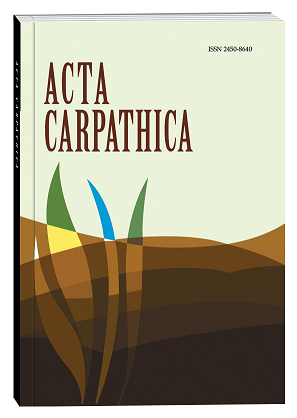MEADOW PHYTOCOENOSES OF THE BYSTRYTSIA TYSMENYTSKA FLOODPLAIN UNDER THE CONDITIONS OF SECONDARY SUCCESSION
DOI:
https://doi.org/10.32782/2450-8640.2024.2.6Keywords:
floodplain, biodiversity, phytocoenosis, secondary succession, anthropogenic load.Abstract
Abstract. The article analyzes the state of meadow phytocenoses of the Bystrytsia Tysmenytska floodplain after pyrogenic load. Among the anthropogenic impacts in this area, pyrogenic changes resulted from burning hayfields and pastures, and the need to destroy ruderal and adventitious species. Such anthropogenic influence led to the formation of a secondary succession. Biodiversity studies of the Bystrytsia Tysmenytska floodplain started in 2021 and continued in 2022–2024. The route method was used to collect field data. The ecological and landscape differentiation of the vegetation cover was studied using the environmental series method, based on the establishment of ecological profiles. In the floodplain valley of the river, 3 ecological profiles have been established. Higher plant determinants have been used to determine the names of vascular species. Five plots were established in the zone of anthropogenic (pyrogenic) influence to determine the species composition of the vegetation. The generally accepted methodology was used for the geobotanical descriptions. The Brown-Blanke method was used for syntaxonomic analysis. Plant abundance was determined using the Drude method. Bystrytsia Tysmenytska belongs to the group of small rivers of the Dniester basin and is characterized by large areas of floodplain meadows, originates in the eastern part of the Upper Dniester Beskydy and has a length of 73 km. In the floodplain areas of the river, the most common are meadow soils on alluvial deposits and sod-middle podzolic sandy and sandy loam, which affect the development of phytobiota. In the studied areas, representatives of the families Asteraceae and Rosaceae were most often encountered, plants of the families Lamiaceae, Poaceae, Fabaceaewere less numerous, representatives of the families Caprifoliaceae, Apiaceae, Ranunculaceae, Equisetaceae, Euphorbiaceae, Plantaginaceae rarely grew. Among the identified species, the following were common and numerous in the study area: Achillea millefolium, Elymus repens, Cirsium arvense, Equisetum arvense. Ranunculus acris, Vicia cracca, Daucus carota, Carduus nutans, Mentha longifolia, which usually did not have a dominant role in phytocenoses, were much less common. Separate fragments of Agrimonia eupatoria, Tanacetum vulgare L., Rubus caesius, Potentilla anserina occurred. The secondary succession of the meadow biocenosis in the floodplain of the Bystrytsia-Tysmenytsia river, which was formed as a result of the pyrogenic load, is characterized by rapid processes of phytobiota restoration, primarily by groups of medicinal plants.
References
1. Балашов Л. С., Соломаха С. А. Класифікація екосистем заплавних лук України. Український фітоценологічний збірник. Київ, 2005. Вип. 1. (23) С. 108–114.
2. Козир М. С. Динаміка рослинного покриву заплавних луків р. Сейм. Актуальні проблеми ботаніки та екології : Міжнар. конф. мол. учених. Кам’янець-Подільський, 13–18 серпня 2008 р. Київ, 2008. С. 157–158.
3. Козир М. С. Антропогенні зміни рослинності заплави річки Сейм. Екосистеми, їх оптимізація і охорона. 2014. Вип. 10. С. 46–51.
4. Козак Ю. В. Еколого-ценотична диференціація заплавної рослинності м. Луцька. Біологічні системи. 2017. Т. 9. Вип. 1. С. 108–114.
5. Кузярін О. Т. Прируслова деревно-чагарникова рослинність в басейні Західного Бугу. Наук. зап. Держ. природозн. музею. Львів, 2011. Вип. 27. С. 109–118.
6. Малиновський А. К. Сукцесії рослинності в річкових долинах Українських Карпат. Вісник Львів. ун-ту. Сер. біол. 2002. 29. С. 77–85.
7. Antoniadou C., Voultsiadou E., Chintiroglou C. C. Succession and Colonization. Encyclopedia of Ecology. 2019. 369–378. https://doi.org/10.1016/B978-0-12-409548-9.10594-9.
8. Hubbell S.P. The Unified Neutral Theory of Biodiversity and Biogeography. 2001. Princeton, NJ: Princeton University Press.
9. Jutila H.M. Vascular plant species richness in grazed and ungrazed coastal meadows, SW Finland. Ann. Bot. Fennici. 1997. 34. 245–263.
10. Kull K., Zobel M. High species richness in an Estonian wooded meadow. J. Veg. Sci. 1991. 2. 711–714.
11. Luoto M., Pykala J., Kuussaari M. Decline of landscape-scale habitat and species diversity after the end of cattle grazing. J. Nat. Conserv. 2003. 11. 171–178.
12. Proulx M., Mazumder A. Reversal of grazing impact on plant species richness in nutrientpoor vs. nutrient-rich ecosystems. Ecology. 1998. 79. 2581–2592.
13. Szirmai O., Czóbel S. Long term scale changes of land use in peasant farming of the Tardona Hills. Cereal Res. Commun. 2006. 34. 837–840.
14. Yassir I., van der Kamp J., Buurman P. Secondary succession after fire in Imperata grasslands of East Kalimantan, Indonesia. Agriculture, Ecosystems & Environment. 2010. 137 (1–2). 172–182.
15. Young T. P., Petersen D. A. et al. The ecology of restoration: historical links, emerging issues and unexplored realms. Ecology Letters. 2005. 8. 662–673.

